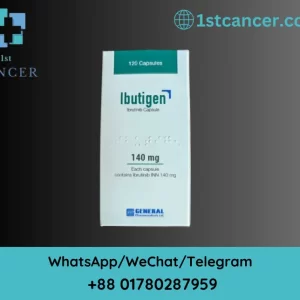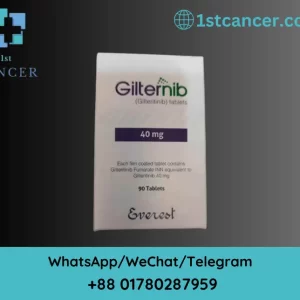Azacitidine Tablets, a nucleoside analogue with epigenetic-modifying properties, stands as a pivotal player in the realm of hematologic oncology. This article delves into the details of Azacitidine, exploring its background, mechanism of action, clinical uses, ongoing research, potential side effects, and emerging trends, unraveling the intricate tapestry of its role in the management of hematologic disorders.
Introduction of Azacitidine Tablets (Azarest):
In the intricate landscape of hematologic oncology, Azacitidine Tablets emerges as a beacon of innovation,

harnessing the power of epigenetic modulation to transform the treatment paradigm. Originally conceived as a chemotherapeutic agent,
Azacitidine’s unique journey has transcended traditional cytotoxic approaches, unveiling its potential as a masterful orchestrator of cellular reprogramming. This introduction navigates the complexities of Azacitidine, shedding light on its background, mechanism of action, and the transformative role it plays in the management of hematologic disorders.
Background: Azacitidine, a cytidine analogue, found its initial purpose in the realm of chemotherapy. However, its distinctive attribute lies in its capacity to modify DNA methylation patterns, setting it apart as an epigenetic modifier with far-reaching implications. The evolution of Azacitidine from a conventional chemotherapeutic to a targeted epigenetic tool has redefined the therapeutic landscape, particularly in the context of hematologic malignancies.
Unveiling the Mechanism of Action:
At its core, Azacitidine Tablets operates as a hypomethylating agent, embarking on a journey into the nucleus of cells affected by hematologic disorders. Its brilliance lies in disrupting DNA methylation, a fundamental process crucial for regulating gene expression. By incorporating into DNA and inhibiting DNA methyltransferases, Azacitidine orchestrates a symphony of events leading to DNA hypomethylation. This epigenetic rewiring, in turn, reactivates silenced genes, offering a molecular avenue to restore normal cellular function.
Clinical Uses:
Azacitidine’s clinical repertoire spans a spectrum of hematologic conditions, with myelodysplastic syndromes (MDS) being a focal point. Its efficacy extends to acute myeloid leukemia (AML) and chronic myelomonocytic leukemia (CMML), where its epigenetic finesse demonstrates therapeutic impact. Notably, Azacitidine Tablets has emerged as a standard of care, especially for higher-risk MDS patients, transforming the treatment landscape with its precision and versatility.
In the chapters that follow, this article navigates through Azacitidine’s pivotal role in clinical uses, ongoing research, potential side effects, and emerging trends, unraveling the intricate tapestry of its influence on hematologic oncology. As we delve deeper into the details, the story of Azacitidine Tablets unfolds as a narrative of innovation, redefining not only the treatment approach but also the outlook for patients confronting hematologic disorders.
Background of Azacitidine Tablets (Azarest):
The story of Azacitidine Tablets unfolds against the backdrop of a dynamic evolution in the treatment of hematologic disorders. Originally conceived as a chemotherapeutic agent, Azacitidine’s journey transcends traditional cytotoxic approaches, finding a distinctive niche in the realm of epigenetic modulation. Understanding the background of Azacitidine requires tracing its development, unraveling its pharmacological foundations, and appreciating the pivotal moments that transformed it from a conventional drug into a paradigm-shifting therapeutic tool.
Development and Early Use:
Azacitidine Tablets, a cytidine analogue, was synthesized in the mid-20th century as part of a wave of nucleoside analogue development. Its initial foray into the medical landscape was rooted in its cytotoxic properties, designed to impede the rapid proliferation of cancer cells. Early applications centered around its use as a chemotherapeutic agent in the treatment of various malignancies, marking a modest beginning for what would become a transformative player in hematologic oncology.
Epigenetic Insight and DNA Methylation:
The pivotal shift in Azacitidine’s trajectory came with a deeper understanding of epigenetics, particularly the role of DNA methylation in the regulation of gene expression. Researchers recognized that abnormal DNA methylation patterns played a crucial role in the pathogenesis of hematologic disorders, providing a rationale for exploring agents capable of modulating these patterns. Azacitidine Tablets emerged as a frontrunner in this endeavor due to its ability to disrupt DNA methylation processes.
Transition to Epigenetic Modifier:
As the scientific community delved into the intricate world of epigenetics, Azacitidine’s potential as an epigenetic modifier gained prominence. Unlike traditional chemotherapies that indiscriminately targeted rapidly dividing cells, Azacitidine Tablets showcased a more nuanced approach. By specifically targeting DNA methyltransferases, enzymes involved in DNA methylation, Azacitidine Tablets initiated a cascade of events leading to DNA hypomethylation.
Expanding Therapeutic Horizons:
The shift from a chemotherapeutic agent to an epigenetic modifier expanded Azacitidine’s therapeutic horizons. Its unique mechanism of action allowed for the reprogramming of aberrant cellular processes, especially in the context of hematologic malignancies. Myelodysplastic syndromes (MDS) became a focal point for Azacitidine Tablets, where its efficacy in higher-risk patients laid the foundation for its widespread adoption.
Today, Azacitidine Tablets stands as a testament to the transformative power of understanding the molecular intricacies of disease. Its journey from conventional chemotherapy to an epigenetic tool reflects the dynamic nature of scientific inquiry and the relentless pursuit of more targeted and effective treatments in hematologic oncology. In the subsequent sections, we delve deeper into Azacitidine’s mechanism of action, clinical applications, ongoing research, and its pivotal role in shaping the future of hematologic cancer care.
Mechanism of Action of Azacitidine Tablets (Azarest):
Myelodysplastic syndromes (MDS) are a group of heterogeneous hematological disorders characterized by ineffective hematopoiesis, leading to cytopenias and an increased risk of progression to acute myeloid leukemia (AML). Azacitidine, a nucleoside analog, has emerged as a promising therapeutic option for patients with MDS. This article explores the intricate mechanism of action of azacitidine and its impact on the pathophysiology of MDS.
-
Introduction:
Azacitidine is a cytidine analog that exerts its therapeutic effects through the disruption of DNA methylation, a crucial epigenetic modification involved in the regulation of gene expression. The drug has been approved for the treatment of MDS, including both lower-risk and higher-risk subtypes.
-
DNA Hypomethylation:
Azacitidine functions as a demethylating agent by incorporating into DNA during cellular replication. Once integrated, azacitidine forms covalent bonds with DNA methyltransferases, irreversibly inhibiting their activity. DNA methyltransferases are enzymes responsible for the addition of methyl groups to cytosine residues, a process critical for the regulation of gene expression.
-
Reactivation of Tumor Suppressor Genes:
The primary consequence of azacitidine-induced DNA hypomethylation is the reactivation of silenced tumor suppressor genes. In MDS, aberrant hypermethylation of specific genes contributes to the dysregulation of cellular processes, including apoptosis and differentiation. Azacitidine’s demethylating action restores the normal expression patterns of these genes, promoting the restoration of normal hematopoiesis.
-
Induction of Cell Cycle Arrest and Apoptosis:
Azacitidine disrupts the cell cycle progression of malignant cells by inducing cell cycle arrest and apoptosis. The drug’s interference with DNA methylation leads to the activation of signaling pathways that mediate these processes. This selective cytotoxicity towards abnormal hematopoietic cells is a key factor in its therapeutic efficacy.
-
Immune Modulation:
Apart from its direct effects on malignant cells, azacitidine also exerts immunomodulatory effects. The drug enhances the immune recognition of cancer cells by upregulating the expression of tumor-associated antigens. Additionally, it promotes the activation of immune effector cells, such as T lymphocytes, further contributing to the elimination of malignant clones.
-
Clinical Implications:
Azacitidine Tablets has demonstrated clinical efficacy in improving overall survival and delaying disease progression in patients with MDS. Its mechanism of action aligns with the underlying epigenetic alterations observed in MDS, making it a targeted therapeutic option for this patient population.
-
Conclusion:
In conclusion, azacitidine’s mechanism of action involves the disruption of DNA methylation, leading to the reactivation of tumor suppressor genes, induction of cell cycle arrest and apoptosis, and modulation of the immune response. Understanding these molecular processes is crucial for optimizing the use of azacitidine in the treatment of myelodysplastic syndromes. Ongoing research continues to explore combination therapies and identify predictive biomarkers to enhance the drug’s efficacy and improve patient outcomes.
Clinical Uses of Azacitidine Tablets (Azarest):
Azacitidine Tablets, a nucleoside analog with potent demethylating properties, has emerged as a cornerstone in the treatment of various hematological disorders. This article provides a comprehensive review of the clinical uses of azacitidine, focusing on its efficacy and applications in diverse clinical settings.
-
Myelodysplastic Syndromes (MDS):
Azacitidine Tablets is FDA-approved for the treatment of MDS, encompassing both lower-risk and higher-risk subtypes. Clinical trials have demonstrated its efficacy in improving overall survival, delaying disease progression, and ameliorating cytopenias associated with MDS. The drug’s mechanism of action, involving DNA demethylation and reactivation of tumor suppressor genes, addresses the underlying pathophysiology of MDS.
-
Acute Myeloid Leukemia (AML):
In older adults with AML who are unfit for intensive chemotherapy, Azacitidine Tablets has shown significant clinical benefits. It is commonly used in the frontline setting and has demonstrated improved survival outcomes compared to conventional care regimens. The drug’s ability to induce cell cycle arrest and apoptosis in malignant cells contributes to its effectiveness in AML.
-
Chronic Myelomonocytic Leukemia (CMML):
CMML, a clonal hematopoietic disorder with features of both myelodysplasia and myeloproliferative neoplasms, poses unique therapeutic challenges. Azacitidine Tablets has demonstrated efficacy in managing CMML, providing a valuable treatment option for patients with this complex hematological condition.
-
Off-Label Uses and Investigational Settings:
Beyond its approved indications, Azacitidine Tablets is being explored in various off-label and investigational settings. Clinical trials are investigating its role in combination therapies, such as in combination with other hypomethylating agents or targeted therapies. Additionally, its potential application in other hematological malignancies and solid tumors is under active investigation.
-
Hematopoietic Stem Cell Transplantation (HSCT) Preparative Regimen:
Azacitidine Tablets is utilized as a part of conditioning regimens prior to allogeneic hematopoietic stem cell transplantation, especially in patients with AML and MDS. This pre-transplant strategy aims to reduce disease burden, enhance engraftment, and improve overall transplant outcomes.
-
Practical Considerations and Future Directions:
Optimal dosing, treatment duration, and patient selection are essential considerations in the clinical use of azacitidine. Ongoing research is focused on identifying predictive biomarkers, refining treatment algorithms, and exploring combination strategies to further enhance the drug’s efficacy and broaden its clinical applications.
-
Conclusion:
Azacitidine’s versatility in addressing the epigenetic dysregulation seen in various hematological disorders underscores its importance in contemporary oncology. As ongoing research continues to unveil new applications and refine existing treatment paradigms, azacitidine remains a crucial component in the therapeutic armamentarium against hematological malignancies.




